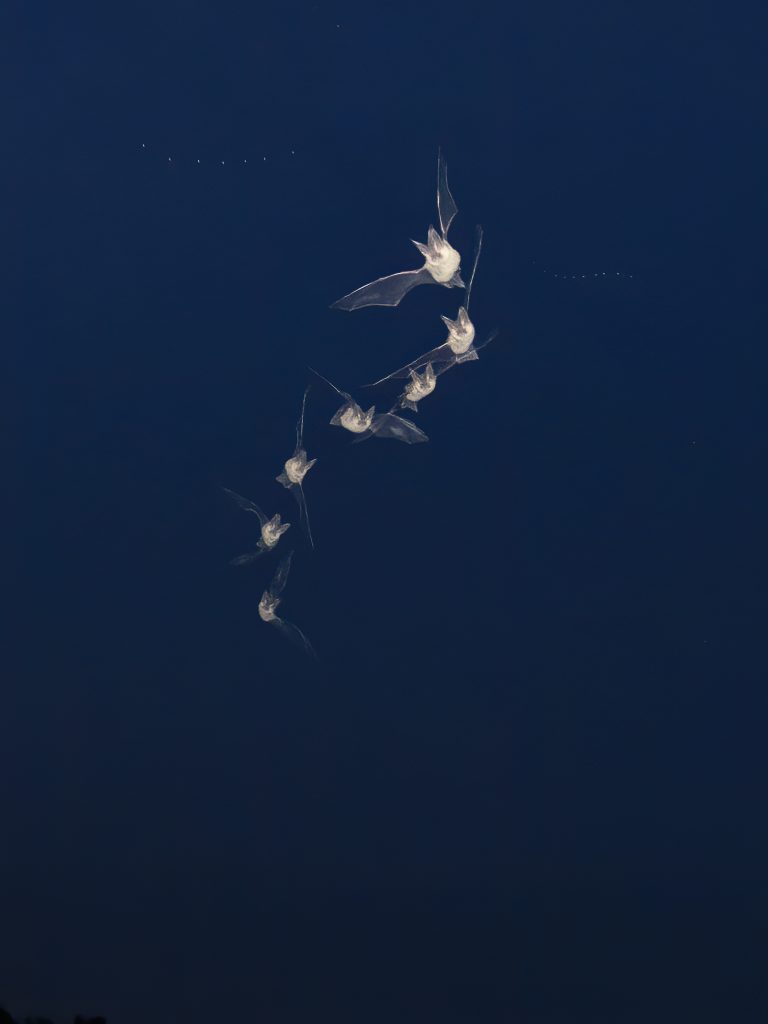I have held a licence from Natural England* to survey and photograph bats since 2001, but for various reasons I had never fulfilled my long-held aspiration of photographing these nocturnal, fast-moving and unpredictable creatures in flight until 2020. Lockdown in spring of last year provided me with the time and opportunity to make a start on this long-anticipated project.

Fortunately, I have a ‘night roost’ for small numbers of the nationally rather rare Lesser horseshoe bat at the rear of our Devon house, so I had the perfect location for initial experimentation. After extensive research, I found that the simplest photographic technique would be to use a laser beam-type trigger to fire multiple flashes, whilst the camera shutter remained open. This would avoid the problem of shutter lag (during which time a bat can fly an unpredictable distance past a pre-set focus point). By trial and error I found that repeated 30 second exposures throughout the night were fine for our house roost, since the small number of bats present meant there would be minimal risk of a frame capturing more than one animal per shot (many bats passing through the frame could result in ghosted images).
I moved from Canon full frame to Olympus in early 2018 for my wildlife work, and at the beginning of the project I had reservations about whether the Olympus M43 sensor – good though it undoubtedly is – would be up to such a demanding task as high speed night-time photography. Whilst I did have to understand and work within the capability of the M43 sensor, and whilst some images required very careful processing to control occasional noise in the shadows, I was pleased to find the Olympus system is more than capable of capturing great bat images, as I hope you will agree. For the images in this blog entry I used a tripod-mounted Olympus EM1x camera coupled with short zoom lenses (including the Olympus 7-14mm f2.8). The images were lit with speed-light flashes fired directly by a laser beam trigger (or manually when flashes were set to ‘strobe’ mode).
My biggest challenge at the outset was pretty basic – how to focus accurately? Taking into account the fast response time of my laser trigger (around 10ms) and the estimated bat flight speed (determined from research papers as between 3ms-1 and 5ms-1), I estimated that pre-focusing 1.5cm beyond the beam would take account of the likely distance travelled by the bats before the flashes fired. The other potential issue was battery life. I found after initial experimentation that when shooting continuously, the EM1x with fully charged batteries would run for around 5.5 hours. Therefore, by switching the camera on around 11.00 pm the system would run until just after dawn. This was perfect for capturing bats using the roost during the night since they would leave to return to their nearby main roost well before sunrise anyway. Later in the project I invested in an adaptor and power pack so the equipment could be switched on much earlier in the evening, allowing an easier and more consistent setup during daylight hours.
The first few weeks were disappointing and frustrating in equal measure – most exposed frames were dark, and whilst a few shots contained bats, most were out of focus or had part of the animal out of frame. However, by incrementally adjusting camera framing and settings, by gradually adjusting flash settings and flash head position, and by experimenting with focus point positioning, I gradually began to get improved results. This nightly trial and error (which included a period of six weeks when I experienced technical challenges with unsynchronised flashes and image ghosting) finally enabled me to establish a consistent system of photographing emerging bats, as well as of bats flying through nearby wooded vegetation. I eventually settled on the following settings for the non-strobe bat shots – ISO 640, a 30 second exposure (with the camera set to continuous shooting) at f10, with five flashes at 1m distance from a pre-set focus point of 1.5cm from the laser beam. All flashes were in manual mode at 1/16th power to give an ‘effective shutter speed’ of around 1/8000th of a second (i.e. sufficient to stop in-flight action).
In summer 2020 I also began to experiment photographing bats foraging in open habitat (initially around our garden) using a mobile setup with the EM1x on a tripod coupled with a pair of bracket-mounted flashes set to ‘strobe mode’ (usually around seven pulses, at 14 pulses per second). I found that an ultrasound bat detector was an invaluable aid in helping to determine when the bats were approaching, and thus when was the appropriate time to press the shutter button to capture individuals passing across the frame. Whilst this is a more interpretive style of photography, I think it does give the viewer a sense of how bats really fly and forage.
The cooler nights of autumn saw a reduction in bat activity and so I called a halt to the project until 2021. Although there is great deal of room for improvement in my images, I have been pleased with progress so far. Hopefully 2021 will see further progress, with more and better images from a wider variety of species!
*Note on legislation and licensing: Whilst research indicates that bats are unlikely to be disturbed providing that flash power settings / durations are kept very low, all photography for this project has been undertaken under the appropriate Class II licence from Natural England, which I have held since 2001.


